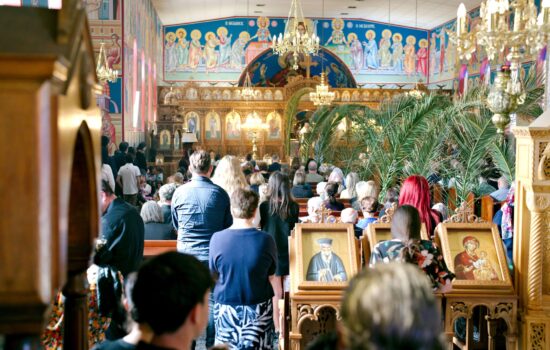by Very Revd Fr Anastasios Bozikis (Associate Lecturer in Church History at St Andrew’s Greek Orthodox Theological College)
As we approach the end of the year and the great Feast of Christmas, Orthodox Christians in Australia will be celebrating the birth of our common Saviour on different days. Along with Christians of other traditions, Orthodox of Greek, Lebanese or Romanian extraction will be commemorating the Nativity on December 25 but those of North Macedonian, Russian or Serbian descent will be marking the Feast on January 7, thirteen days later. Quite apart from differences in language, customs and administrative structures amongst the Orthodox in this country, the disparity between our liturgical calendars remains the most obvious expression of our internal dissensions and our divided witness to the outside world. How, then, did we reach this situation?
People have always sought to develop reliable systems that could measure the passing of time. For this task the great ancient civilisations generally used the actual and perceived movements of the moon and/or sun as the standard measure. A lunar calendar was used by both the ancient Greeks and the Jews for this purpose. It developed to such a degree of accuracy by the fourth century BC that it has remained unchanged since then. It consists of twelve months with each month alternately having either thirty or twenty-nine days for a total of 354 days. It therefore falls short of the solar year which developed in Egypt and measured the period between one vernal (spring) equinox and the next. With his conquest of Egypt, Julius Caesar sought to adopt the solar calendar in a more precise form in Rome. On the advice of the Alexandrian astronomer Sosogenes the year was calculated to be 365 days and six hours. To account for this extra six hours it was decided that one full day would be added on to every fourth (leap) year. The reconciliation of the lunar year with the solar year proved to be quite difficult. It was eventually established that every seventy-six years the lunar and Julian solar calendars would begin together on precisely the same day and hour.
Nevertheless the Julian calendar was not totally accurate. It fell behind the actual movement of the sun by about eleven minutes every year. In 1582 the difference between the Julian calendar and the sun was a full ten days – today it is thirteen days – and Pope Gregory XIII was convinced by his astronomers of the need to correct it. Therefore the Pope decreed that the day after the 4th October 1582 would be the 15th October. To prevent this situation from recurring it was further decreed that in every 400 year period there should not be 100 leap years, as was the case with the Julian calendar, but only ninety-nine. This was achieved by declaring that ‘century’ years (eg. 1600, 1700, 1800 etc.) would not be leap years unless they could be divided by 400. So under the new Gregorian calendar the years 1900 and 2100 are not leap years though the year 2000 was, whereas for the Julian calendar each of those ‘century’ years were, in fact, leap years.
The Gregorian changes to the calendar were immediately rejected by the Orthodox Churches as well as by most Protestants in Western Europe.[1] In 1583 Ecumenical Patriarch Jeremias II dismissed Papal overtures on this matter declaring the new calendar a ‘world-wide scandal’ because it flouted the Tradition and canons of the Orthodox Church by permitting the celebration of Easter (Pascha) to occur before the Jewish Passover in direct contravention to the Apostolic Canons and the decisions of the First Ecumenical Synod in Nicaea in 325. Three Pan-Orthodox Synods in 1583, 1587 and 1593 condemned the Gregorian calendar because it violated the Paschalion (the process of establishing the date of Easter and associated feasts such as Pentecost); it was introduced unilaterally by the Pope without any consultation with the East; and, was being used by the Latins as a propagandistic tool in their attempts to proselytise the Orthodox of the Middle East.
By the beginning of the twentieth century the question of reforming the Julian calendar was again being raised in the Orthodox world. At the prompting of Patriarch Joachim III the various Orthodox churches began to debate the matter seriously. In 1919 the Church of Greece issued an opinion that would allow for a new calendar with the agreement of all the autocephalous Orthodox churches as long as the Gregorian calendar was not adopted but that, until such time, no change should be made by any church unilaterally. In 1920 the Ecumenical Patriarchate published an Encyclical in which it encouraged Orthodox participation in the inter-Christian ecumenical movement and called for ‘…the adoption by all the churches of one single calendar so that the great Christian feasts may be everywhere celebrated simultaneously…’
Amongst other initiatives, the ‘Pan-Orthodox’ Congress convoked by Ecumenical Patriarch Meletios IV Metaxakis in 1923 – which was boycotted by the other Patriarchates – also decided that a new Revised Julian calendar be introduced for the Orthodox Church which, for all intents and purposes coincided with the Gregorian calendar and would align all the fixed feasts, such as the Annunciation and Christmas, as well as all the moveable feasts of the Paschalion, such as Easter and Pentecost, with the western calendar. A new, pro-Western revolutionary government in Greece pressured the Church there to adopt this new calendar the next year and so, in 1924, the 10th March became the 23rd March, for by this time there was a thirteen-day difference between the two calendars. As it had now become obvious that the change would not be acceptable to all the Orthodox churches, the Church of Greece proposed that the date of Easter remain unaltered and continue to be calculated according to the Julian Calendar so as not to violate the canons of the Ecumenical Synods.
This innovation immediately created a liturgical division in the Orthodox world – both between the various autocephalous churches, some which accepted the change and some which did not, but also within those churches which adopted the new calendar with the emergence of the Old Calendarist movement. The Orthodox Churches that adopted this new hybrid model were Constantinople, Greece, Cyprus and Romania in 1924; Alexandria and Antioch in 1928; Albania in 1937; Bulgaria in 1968 and the Orthodox Church of Ukraine under Metropolitan Epiphany in 2023 as well as the Orthodox Church in America (OCA). Churches that have continued with the Julian Calendar include Jerusalem, Russia, Serbia, Georgia, Poland, North Macedonia, the Russian Orthodox Church Abroad, Sinai, Mt Athos and the Ukrainian Orthodox Church under Metropolitan Onouphry.[2]
As Orthodox Christians of different nationalities migrated to Australia and other parts of the world they brought their particular calendar with them. And so this year, once again, some Orthodox will celebrate Christmas on December 25 according to the Gregorian and Revised Julian calendars while others will celebrate the same Feast thirteen days later on December 25 according to the Julian calendar (ie. January 7). Perhaps this may serve as a reminder to us of the tragic divisions that beset us as an Orthodox Church and prompt us, on whichever day we celebrate Christmas, to reflect on the confused nature of our liturgical witness to the great mystery of the Incarnation for a world in search of its Saviour.




















